LET - To allow to, not to prevent (+ infinitive, but usually without to).
LIE - To be in a horizontal position.
LIT - Little.
NET - A mesh of string, cord or rope.
TEN - A numerical value equal to 10; the number occurring after nine and before eleven, represented in Roman numerals as X, in Arabic numerals as 10, and in the hexadecimal system (base 16) as A.
TIE - A necktie (item of clothing consisting of a strip of cloth tied around the neck).
TIN - A malleable, ductile, metallic element, resistant to corrosion, with atomic number 50 and symbol Sn.
NIL - Nothing; zero.
LINE - A path through two or more points (compare 'segment'); a continuous mark, including as made by a pen; any path, curved or straight.
TELL - To count, reckon, or enumerate.
TILE - A regularly-shaped slab of clay or other material, affixed to cover or decorate a surface, as in a roof-tile, glazed tile, stove tile, etc.
TILL - To.
LILT - To do something rhythmically, with animation and quickness, usually of music.
LINT - A fine material made by scraping cotton or linen cloth; used for dressing wounds.
LITE - Light in composition, notably low in fat, calories etc.:.
LIEN - A tendon.
TINE - A spike or point on an implement or tool, especially a prong of a fork or a tooth of a comb.
INLET - To let in; admit.
LENTIL - Any of several plants of the genus Lens, especially Lens culinaris, from southwest Asia, that have edible, lens-shaped seeds within flattened pods.
LINTEL - A horizontal structural beam spanning an opening, such as between the uprights of a door or a window, and which supports the wall above.








